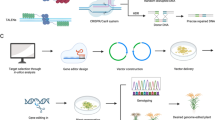Abstract
Inbreeding depression occurs in haploid (2n = 2X = 24) potatoes (Solarium tuberosum L.) extracted from tetraploid (2n = 4X = 48) potatoes. This depression has been postulated to occur due to the loss of intralocus interactions, the loss of favorable epistatic combinations in normal meiosis, inbreeding depression, or the exposure of deleterious genes. The inbreeding coefficient of haploids extracted from tetraploids is derived in this paper. This inbreeding coefficient is a function of the inbreeding levels in the parents, the coefficient of coancestry of the parents, and the coefficient of double reduction. When the coefficient of double reduction is greater than zero, the inbreeding coefficient of the haploid is greater than the inbreeding coefficient of the tetraploid from which it was extracted. The implications of these results on breeding strategies employing haploids is discussed.
Compendio
Ocurre una depresion del retrocruzamiento en papas (Solanum tuberosum L.) haploides (2n = 2x = 24) extraídas de papas tetraploides (2n = 4x = 48). Se ha asumido que esta depresión ocurre debido a la pérdida de interacciones de intralocus, a la pérdida de combinaciones epistáticas favorables en meiosis normales, a la depresión del retrocruzamiento, o a la exposición de genes perniciosos. En este documento, se obtiene el coeficiente del retrocruzamiento de haploides extraídos de tetraploides. Este coeficiente de retrocruzamiento es una función de los niveles de retrocruzamiento en los padres, el coeficiente de la coascendencia de los mismos, y el coeficiente de doble reducción. Cuando el coeficiente de doble reducción es mayor que cero, el coeficiente de retrocruzamiento del haploide es mayor que el coeficiente de retrocruzamiento del tetraploide del que fue extraído. Se discute las implicancias de estos resultados sobre las estrategias de mejoramiento que emplean haploides.
Similar content being viewed by others
Literature Cited
Chase, S.S. 1963. Analytic breeding inSolanum tuberosum L. -A scheme utilizing parthenotes and other diploid stocks. Can J Genet Cytol 5:359–363.
Crow, J.F. and M. Kimura. 1970. An introduction to population genetics theory. Harper and Row Pub Inc, 591 pg.
De Jong, H. and P.R. Rowe 1971. Inbreeding in cultivated diploid potatoes. Potato Res 14:74–83.
DeMaine, M.J. 1978. Field resistance to late blight and potato root eelworm in group tuberosum dihaploids. Euphytica 27:305–315.
DeMaine, M.J. 1982. An evaluation of the use of dihaploids and unreduced gametes in breeding for quantitative resistance to potato pathogens. J Agric Sci 99:79–83.
DeMaine, M.J. 1984. Patterns of variation in potato dihaploid families. Potato Res 27:1–11.
DeMaine, M.J., L.A. Farrer, and M.S. Phillips. 1986. Breeding for quantitative resistance to potato cyst nematode (Globodera pallida) in tetraploid potatoes using dihaploids and unreduced gametes. Euphytica 39:1001–1006.
Fish, N. and M.G.K. Jones 1988. A comparison of tissue culture response between related tetraploid and dihaploidS. tuberosum genotypes. Plant Cell, Tissue and Organ Culture 15:201–210.
Freyre, R. and D.S. Douches. 1991. Use of molecular markers for the study and analyses of quantitative tuber traits in diploid potatoes (Solanum spp.). Am Potato J 68:609.
Haynes, K.G. 1992. Some aspects of inbreeding in derived tetraploids of potatoes. J Hered 83:67–70.
Haynes, K.G. and D.S. Douches. 1993. Estimation of the coefficient of double reduction in the cultivated tetraploid potato. Theor Appl Genet (In press).
Hermundstad, S.A. and S.J. Peloquin. 1985. Germplasm enhancement with potato haploids. J Hered 76:463–467.
Hermundstad, S.A. and S.J. Peloquin. 1986. Tuber yields and tuber traits of haploidwild species F1 hybrids. Potato Res 29:289–297.
Hougas, R.W. and S.J. Peloquin. 1957. A haploid plant of the potato variety Katahdin. Nature 180:1209–1210.
Hougas, R.W. and S.J. Peloquin 1958. The potential of potato haploids in breeding and genetic research. Am Potato J 35:701–707.
Hougas, R.W., S.J. Peloquin, and A.C. Gabert 1964. Effect of seed-parent and pollinator on frequency of haploids inSolatium tuberosum. Crop Sci 4:593–595.
Hougas, R.W., S.J. Peloquin, and R.W. Ross 1958. Haploids of the common potato. J Hered49:103–107.
Malecot, G. 1969. The mathematics of heredity (Yermanos DM trans). San Francisco: Freeman, 88 pg.
Mather, K. 1935. Reductional and equational separation of the chromosomes in bivalents and multivalents. J Genet 30:53–78.
Mather, K. 1936. Segregation and linkage in autotetraploids. J Genet 32:287–314.
Mendiburu, A.O., S.J. Peloquin and D.W.S. Mok 1974. Potato breeding with haploids and 2n gametes.In: Kasha K.J., (Ed.). Haploids in Higher Plants, Guelph University Press; Guelph, Ontario, Canada: 249–258.
Mendoza, H.A. and F.L. Haynes 1973. Some aspects of breeding and inbreeding in potatoes. Am Potato J 50:216–222.
Mendoza, H.A. and F.L. Haynes 1974. Genetic relationship among potato cultivars grown in the United States. HortScience 9:328–330.
M’Ribu, H. Kaburu and R.E. Veilleux. 1990. Field evaluation of the breeding value of doubled monoploids from a clone of the diploid potato speciesSolarium phureja Juz. & Buk. Am Potato J 67:566.
Mullin, R. and F.I. Lauer 1966. Breeding behavior of F1 and inbred potato clones. Proc Amer Soc Hort Sci 89:449–455.
Peloquin, S.J. and R.W. Hougas. 1960. Genetic variation among haploids of the common potato. Am Potato J 37:289–297.
Ross, H. 1986. Potato breeding: problems and perspectives. Verlag Paul Parey, Berlin/Hamburg, 132 pg.
Sanford, J.C. and R.E. Hanneman, Jr. 1982. Intermating of potato haploids and spontaneous sexual polyploidization-effects on heterozygosity. Am Potato J 59:407–414.
Yerk, G.L. and S.J. Peloquin. 1989. Comparison of 2n and non-2n pollen-producing haploid × wild species hybrids in potato. J Hered 80:468–471.
Yerk, G.L. and S.J. Peloquin. 1990. Selection of potato haploid parents for use in crosses with 2 × (2 Endosperm Balance Number) wild species. Crop Sci 30:943–946.
Author information
Authors and Affiliations
Rights and permissions
About this article
Cite this article
Haynes, K.G. Some aspects of inbreeding in haploids of tetraploidSolanum tuberosum L.. American Potato Journal 70, 339–344 (1993). https://doi.org/10.1007/BF02851427
Accepted:
Issue Date:
DOI: https://doi.org/10.1007/BF02851427




